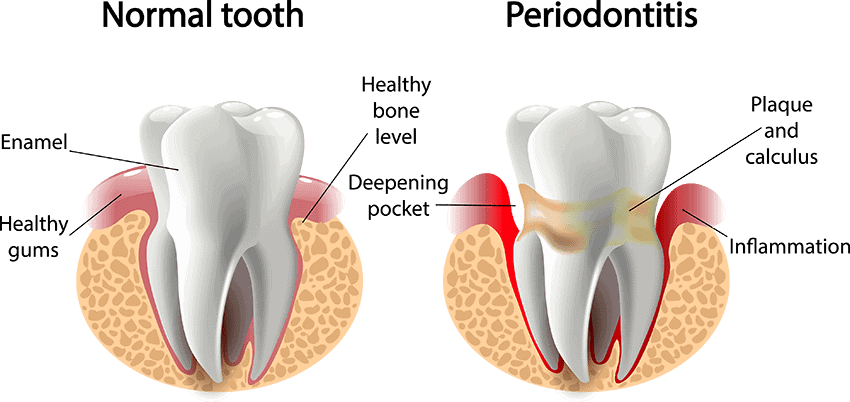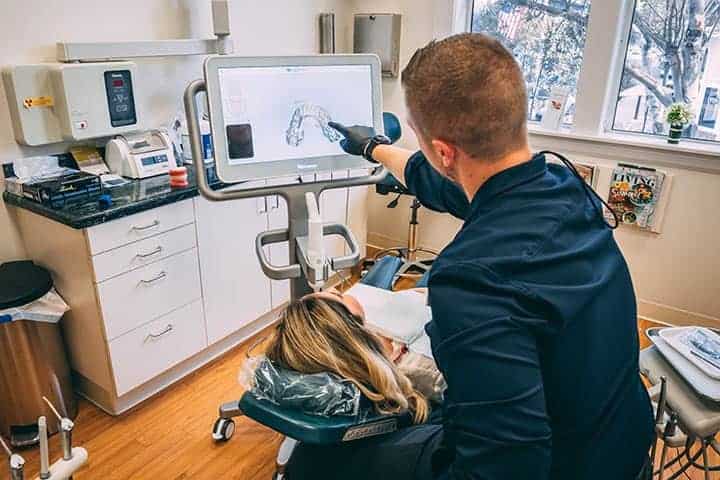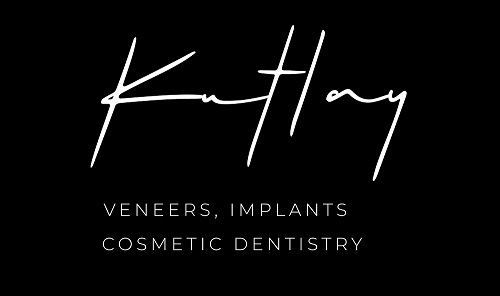Cosmetic Dentistry – Periodontal Disease
What is Periodontal Disease?
The word “periodontal” means “around the tooth.” Periodontal Disease (also known as “gum disease”, “pyorrhea” or “periodontal infection”) is a chronic bacterial infection in the gums and bone around your teeth. This infection causes the gums to be inflamed, swollen and tender. Bleeding when brushing, flossing or eating is common. If it isn’t treated, the inflammation can destroy the bone that anchors the teeth resulting in tooth looseness and eventual tooth loss. Periodontal infection is the cause of 75% of all adult tooth loss.
More importantly, scientific research has confirmed an association with periodontal infection to several serious medical conditions including heart disease, diabetes and stroke. It is the inflammation present in the gums that triggers a threatening chain reaction in the bloodstream that can contribute negatively to these other conditions. As ongoing research continues to define how periodontal disease is connected with these and other health problems, it is clear that good oral health is essential. Achieving and maintaining good periodontal health is a key component to achieving overall wellness and whole-body health.
The warning signs of gum disease
If you notice any of the following signs, you probably have gum disease and need treatment:
- Gums (gingivae) that bleed easily
- Red, swollen or tender gingivae
- Gums that have pulled away from the teeth
- Pus between the teeth and gingivae when the gingivae are pressed
- Persistent bad breath or bad taste
- Permanent teeth that are loose or separating.
- Any change in the way your teeth fit together when you bite
- Any change in the fit of your partial denture.
What is periodontitis?
Early gum disease is called gingivitis. It involves inflammation of the soft gum tissues only. When it progresses to affect the bony support of the teeth, it is called periodontitis. Periodontitis is a chronic inflammatory disease, like arthritis, only it causes the supporting structures of your teeth to dissolve away. It can go on for years before you ever notice any symptoms, and the first symptom may be loose teeth. At that point, it may be too late to treat the disease and you may have to extract teeth.

Stages of Periodontal Disease
On the basis of its severity, area involved and associated complications, gum disease can be divided into the following stages or types:
First Stage – Gingivitis
Clinically known as gingivitis (gingival = gums, itis = inflammation), the first stage of gum disease simply refers to the inflammation of your gums. In the early or first stage of gum disease, bacteria-laden plaque builds up gradually, eventually irritating the gums. As a result, gum becomes inflamed, may swell, redden and bleed quickly and easily while brushing the teeth.
Characteristics of the first stage of gum disease – gingivitis
- Pocket depth of 2-3mm with bleeding on gentle probing
- Calculus along your sensitive gum line is changed into a rough surface on which plaque accumulates
- Tender, red, inflamed and bleeding gums
- Bad breath may be present
- Spaces between the gum and tooth (periodontal pockets) may exist due to slight detachment of the periodontal fibers that hold the gums tightly against the teeth
- No underlying bone is involved or damaged
This is relatively a mild form of gum disease and is easily reversible if treated early and properly
Second Stage – Early To Moderate Periodontitis
If the first stage is left untreated, it will progress to the second stage. Plaque turns into hard tartar which cannot be removed by brushing alone. This stage of gum disease requires more aggressive treatment to control.
Characteristics of the second stage of gum disease – early to moderate periodontitis
- Probing depth of 4-6mm with bleeding on gentle probing
- Unlike the first stage, plaque and calculus (tartar) is not found “along” but “below” the gum line
- Bad breath may be present
- Tender, red, sore and bleeding gums may also be present
The bite can be affected. Teeth may lose so much support that either they fall out or need to be removed. This third and the final stage of gum disease is irreversible.
Third Stage – Advanced Periodontitis
Also known as severe periodontitis, this stage represents the irreversible and complicated form of gum disease which is characterized by bone involvement, bone loss, tooth looseness, gingival migration, discomfort and tooth loss.
Characteristics of the second stage of gum disease – early to moderate periodontitis
- Probing depth of 7-12mm with bleeding on gentle probing
- Pockets deepen and create more space for increased bacterial activity which leads to more bone and attachment fiber loss
- The deeper pockets may fill with pus
- This pus exists between the teeth and gums and is more visible when the gums are pressed together
- There may be swelling around the root which leads to even greater bone loss
The bite can be affected. Teeth may lose so much support that either they fall out or need to be removed. This third and the final stage of gum disease is irreversible
Treatment For Gum Disease
If you have periodontal disease and want to keep your teeth, it’s going to require some treatment and some slight changes in lifestyle. Here’s the outline of what you need to do:
Initially, you need to get a deep cleaning, also called “scaling and root planing”. Your hygienist will use anesthetic to make your procedure more comfortable. She will then go under your gums and remove all of the calculus (tartar) and microbial debris from the tooth surface. Since this cleaning is more involved, the appointments are usually spaced out over two to five appointments. It’s considerably more expensive than a routine cleaning.

Your hygienist will provide you with important information regarding at-home dental hygiene care after your scaling and root planing.
The initial treatment may also include some medications. This is a developing area of knowledge, but, in the cases of some patients, periodontitis is responding to light doses of a tetracycline to help resist the bone destruction and also antimicrobial irrigation under the gums.
Your teeth will need to professionally cleaned more often. Rather than every six months, you will now need to have your teeth cleaned every two, three, or four months. Your hygienist and Dr. Kutlay will make that determination and recommendation for you.
NEW PATIENT FORMS
NEW PATIENT FORMS
PRE-REGISTER AND SAVE TIMEIf you are a new patient to our office, simply click the “New Patient Online Registration” button below. Once you have completed the forms, click submit, they will automatically be sent to our office.We look forward to meeting you!
PATIENT FINANCING*
PATIENT FINANCING*
The Care-Credit Healthcare Card
Care-Credit is a credit card that helps you pay for treatments and procedures for you or your family that may not be covered by insurance.
You can use your Care-Credit card again and again for your dental needs, as well as at thousands of other healthcare providers, including optometrists, veterinarians, ophthalmologists and hearing specialists.
